|
FAQs about Stony Coral, Cnidarian
Identification 15
Related FAQs: Stony Coral ID 1, Stony Coral ID 2, Stony Coral ID
3, Stony
Coral ID 4, Stony Coral ID 5,
Stony Coral ID 6, Stony Coral ID 7, Stony Coral ID 8, Stony Coral ID 9, Stony Coral ID 10, Coral ID 11, Stony Coral ID 12, Stony Coral ID 13, Stony Coral ID 14, & Cnidarian
Identification, Stony FAQs 1, Stony
FAQs 2, Foods/Feeding/Nutrition, Disease/Health, Propagation, Coral Compatibility, Stony Coral Behavior,
Related Articles: Stony
Corals,
|
.JPG) |
|
Coral identification 12/19/19
I need your help about this coral identification
<Appears to be a Faviid of some sort (Family Faviidae); may be able to guess
further to genus if you can give me an idea of the diameter of the polyps (in
mm.). Bob Fenner>
|
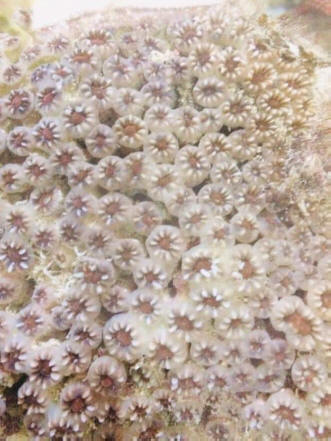 |
|
Puerto Rico coral ID 4/6/18
I have a friend that is in Puerto Rico helping out with environmental cleanup
after the hurricane. She was never really a coral person but needs to ID some
corals and to be honest it has been forever since I dug into the
Caribbean corals. I was wondering if you could give me your expert opinion on 3
of them. Thanks Bob!
Best Regards,
Cory Shank
The first image looks like a Pavona, so i would assume an Agaricia sp.?
<I'm re-answering as I looked at these in another order. Yes to this one being
an Agariciid. I make it out as A. lamarcki>
The second one almost looks like a chalice, I haven't dug to deep and I am quite
rusty with Caribbean corals.
<Mmm, am guessing while I ask friends for their input. Is this a Mycetophyllia
young colony... M. lamarckiana?... Turns out it is likely M. aliciae>
I'm pretty sure the third image is a "HAIRY" Corallimorph, she couldn't give me
anyone except for the image.
<Yes, for me, Rhodactis osculifera. Bob Fenner>
|
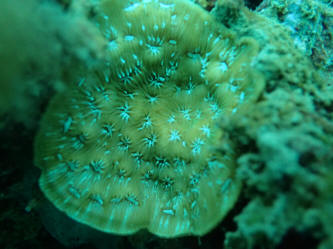 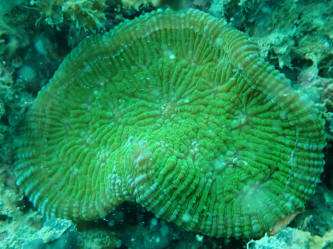
.jpg) |
|
Re: Puerto Rico coral ID 4/7/18
Thanks again Bob!
Hope we can catch up again sometime soon!
Cory
<Me too Cory. BobF>
|
|
Coral IDs for Dale... Megs and megs of bunk pix
3/13/18
Jason from SDMA gave me a bucket of coral. I wanted to know if you could ID
these for me. Sorry for the crappy pics. I don't buy those expensive cell
phones.
<Ah mate...>
And Ill have to send separate emails. I don't know how to take smaller pics.
<Ugh!>
I appreciate any names you can give me. Thank you. Dale.
<This looks to be some species of Mussid, perhaps a Scolymia.... Bob Fenner>
|
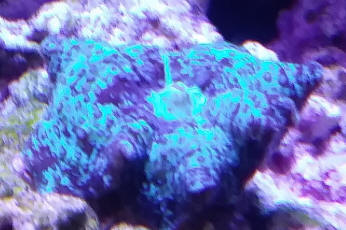 cropped, spiffed
cropped, spiffed |
|
Coral ID 3/13/18
[Images]
<.... Pectiniids? Read here:
http://www.wetwebmedia.com/pectiniids.htm
|
.jpg)
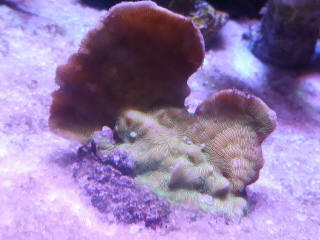 |
|
Re: Coral Identification
5/2/16
I changed Porites astreoides to Acropora crateriformis
<Mmm; maybe... though the polyps don't look like the genus Acropora to me; P.
asteroides is not found in the Pacific. There are of course other Porites spp.>
also I'm not so sure. This is my first time in identifying corals in the field
so I'm really inexperienced. I'm having trouble about the Goniastrea mantonae,
I'm thinking of changing it to Favites abdita or F.vasta. What do you think,
sir?
<Ahh; this might be a Favites species. Do you have access to the works of J.E.N.
Veron? These are about the best... Need close up (a diopter? Perhaps a setting
on your camera if it's a compact digital) pix of corallites... or images of good
size and resolution (clarity) to expand to look close a details. Bob Fenner>
|
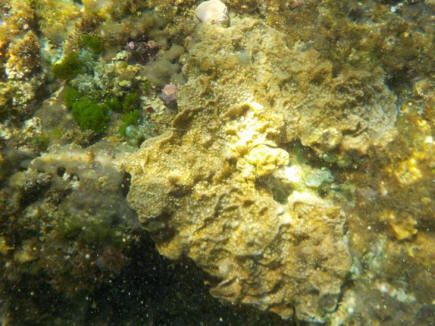 |
|
Re: Coral Identification
5/2/16
Alright sir, I will try to find look for references. You've been a great
help sir, thank you so much!
<Certainly welcome Clarisse. Cheers, BobF>
|
|
LPS Identification 1/6/15
Good Evening The fine crew at WWM,I was wondering if you could help me identify
the coral in the middle of the picture. I was thinking some type of Favia or
Favites, but now I'm not so sure.
<Maybe.... or a Caulastrea species?>
The light green polyps on top are the same as the rest of the coral. Is it
common for younger polyps to have tentacles in the Favites or Favia Venus?
<Genus? Yes>
Any help would be greatly appreciated. Have a great night! Jason
<And you, Bob Fenner>
|
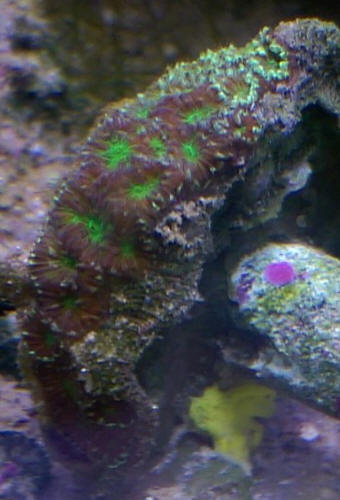 |
|
Re: LPS Identification 1/8/16
Thanks Bob for the speedy reply! I'll check into the Genus Caulastrea, not sure
that is spelled right, but I believe they are not encrusting and what I have is.
<Some species are... Do you have any of Veron's works?>
Either way I believe the care is roughly the same so maybe exact species isn't
necessary.
<Yes; tis so>
I have another question regarding water changes, currently I do 3 gallon changes
daily on a 20 gallon plus 15 gallon sump. I have noticed that I'm starting to
have brown diatoms growing on the glass, do you think that will subside in time?
<Mmm; possibly... a matter of balances... best to do what you can to increase
RedOx, improve skimming, use (prudent) of chem. filter media; poss. use of
competitors>
I know its related to the water changes. My source water is the primo water
refills at Wal-Mart. The water there is suppose to go through a sediment filter,
carbon block, to, and finally UV. I want to get an rodi unit but that will have
to wait. If it wont go away on its own then what is the best way to remove
silicates from the water.
<Ahh; do please search/see/read on WWM Re. Am out diving in Florida and hard to
look u>
Thanks in advance for helping me with my questions and have a great night. Jason
<Thank you. Bob Fenner>
Re: LPS Identification 1/9/16
Bob, As always thanks for your time, effort, and help. I will definitely check
on the 3 volume compendium, and thanks for the website. Jason
<Am very sure you will enjoy and gain by its perusal. A personal note; a dear
(and unfortunately departed) friend, John Jackson, of Odyssey Publishing was
very good friends w/ J.E.N (Charlie) Veron... in fact brought him out to the
MACNA... was it in Boston? Years ago. I'd pre-purchased a set of this work, and
John gifted me one of the hundred leather bound ones... I gave away the first,
and yes; have written in the limited ones... as is my habit. BobF>
|
|
Unknown coral branch... thing.
10/13/15
Hi guys!
<Andrew>
I received what appears to be a piece of some type of branching coral that
I cannot identify.
It's green with a purple cast to it (or visa versa) and has a number of
widely separated polyps. I have not seen them open.
<Mmm; what does this thing feel like? Is it at all flexible? If so, my
tentative group vote is going to a Rindkorallen; a Gorgonian>
It kinda looks like the antagonist from Day Of the Tentacle, which would
be
awesome if true.
Any thoughts?
Andrew
<Bob Fenner>
|
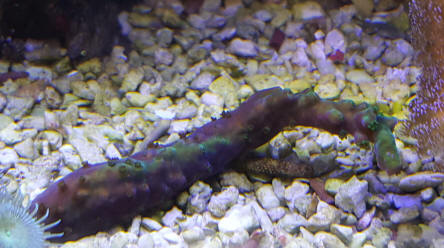
|
Re: Unknown coral branch... thing.
10/15/15
<ten megs....>
Bob/Crew,
No, not at all flexible. Here is another pic, and a pic of the hard internal
structure at the fractured end.
Andrew
<A branching Scleractinian of some sort.... many Families possibilities.
Have to wait till it's larger and more close up pix of corallites to tell more.
Bob Fenner>
|
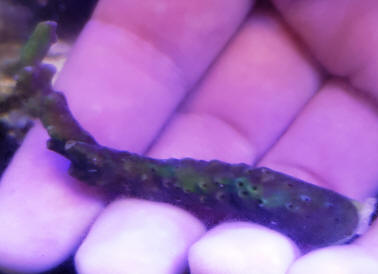
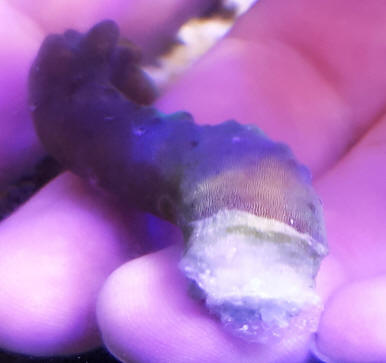 |
|
Re: Unknown coral branch... thing.
10/15/15
Thank you!
<Welcome!>
|
|
|
Re: Coral Calamity In Over My Head
8/23/15
I hope it is ok that I don't restate my tank stats, they are below in original
message. I wanted to send a couple pictures to confirm the identity of my
"cauliflower" coral. His polyps are extended, not as much as at store but the
lighting is more intense. Does he look happy, content? Any ideas about how to
keep him well? Thanks.
<Does look like a Pocillopora! And open... Do see WWM re the family.
http://www.wetwebmedia.com/pocilloporidae.htm
and the linked files at top.
Bob Fenner>
|
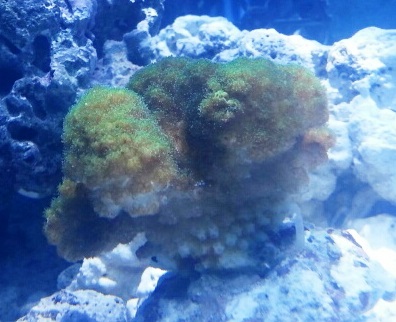 cropped, full size
cropped, full size |
|
Encrusting SPS ID
5/22/15
Hi gang,
Have a coral that we're having trouble identifying. It's really cool. Came as a
hitchhiker and grows pretty fast. Attached pics. Thank you!
<Mmm; due to your stmt. re fast growth, the size and shape of these exsert
polyps, am guessing this is some sort of encrusting Porites... but, am sending
off to friends for their input. Bob Fenner>
|
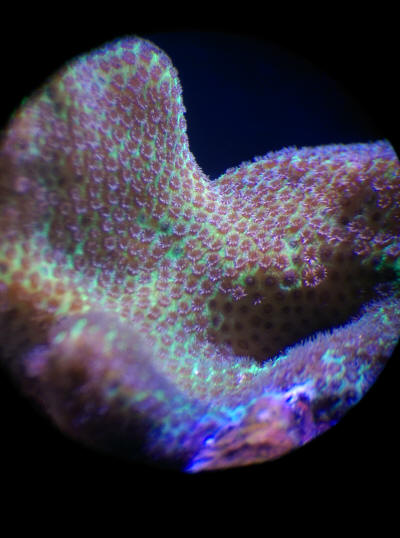
.jpg) |
|
Re: Encrusting SPS ID 5/23/15
Thank you Bob! I was thinking a Porites, but couldn't find an exact match while
combing visual references.
Looking forward to your findings!
<Me too... have sent out to Jake Adams, Walt Smith; asked Lemon TyK on FB...
We'll see. BobF>
|
|
Coral ID 4/21/15
Hey Bob, Robert George Peets posted this coral in one of the fb groups.
Collected off the coast of Bermuda about 30' down. Said the piece that
was around 5' wide.
<Five feet?!>
It has not opened all the way but did eat some mysis. Thought you might know. He
has been involved in coral conservation programs in Bermuda for 12 years and has
no idea what it is. Help would be appreciated.
Thanks,
Lori Johnson
<Mmm; well; the size of polyps, color, the stated shape of the colony... may be
Eusmilia fastigiata... the polyps/skeleton are usually more pronounced. Their
colonies max out at about half this size. A beauty in any case. Bob Fenner>
|
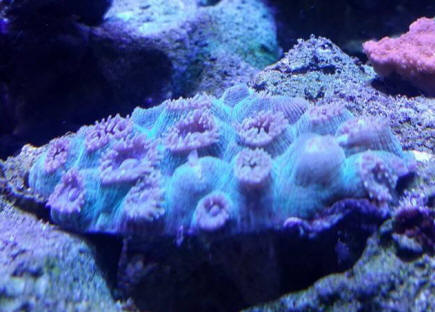 |
|
Galaxea, and mystery Cnidarian
Crew,
<SP>
I first and foremost would like to thank you for the informative
website, and at first I have some good news. I
took in a small Galaxea colony that had
completely bleached about nine days ago, it was completely transparent
except for a few tentacles with had faint green color. Since then
here is the color I have seen develop, it also
was not exhibiting polyp extension in the old
tank. I am frequently surprised at how resilient coral can be.
Anyway, nearly a year ago I emailed about a strange species that
appeared in my fish tank attached to a Favites
colony I purchased. I thought it was
likely Euphyllia of some sort, but it has
exhibited non-Euphylliid behavior
I am fairly certain. It underwent rapid division (started with two
separate individuals and now have over 15 all
differ in size largest is about 3.5 inches) It
had tissue that was attached to the rock, but after the skeleton
reaches about an inch in diameter it somehow
detaches from the rock
(including the skeleton) I know I must sound
crazy, but the colony also is growing
in diameter, but not especially in height. I have had Euphyllia
before, and never seen this kind of growth. I will attach the current
picture as well as the original I sent in and if more are needed
let me
know because Im not sure what this is. In hopes all is well,
Bryce
<Might be Euphyllia; perhaps acanthocauli... from a Fungiid: Heliofungia.
Bob Fenner>
|
.JPG)
.jpg)
.JPG) |
Re: Galaxea, and mystery Cnidarian
Would a picture with retracted tissue, and more skeleton be more helpful?
<If it was a close up and well-resolved, yes. BobF> |
|
What is this ? Scler. ID
3/19/14
I found this coral on a colony of Zoas I received from live aquaria.
Decided to remove from the liverock and add to a frag plug. A couple
months later it's spread like crazy. I have searched everywhere and
still have no clue what it may be.... Any help would be greatly
appreciated!!
-Matt
<That pattern.... Is this Merulina? Bob Fenner>
|
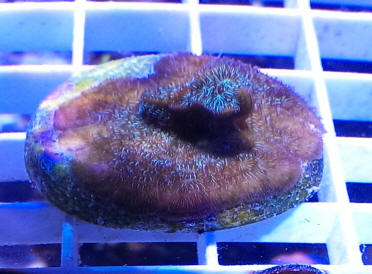 |
|
trying to ID a coral 1/30/14
Greetings! I am really enjoying this site. I have a 65 gal
tank with a 20 sump. There is liverock and sand. I recently bought
another small piece of live rock I thought had dead coral on it. I'm
thinking it might still be alive! I am trying to figure out what
exactly it is I have and how to take care of it. I have showed a few LFS
staff the attached picture and they think it's a sun cup?
<Likely a Dendrophylliid; though some of the Caryophylliids could be
considered>
I guess I'm not sold on it because of the coloring and spacing between
tubes. I've looked through pictures on this site and see possibilities
of Goniopora and Dendrophyllildae( black tube)?. What do you think? I'm
very excited because I'm wanting to branch out and try some low light
corals and macroalgae to spruce up my tank.
Thanks! Tracy
<See the pix of both families on WWM. Bob Fenner>
|
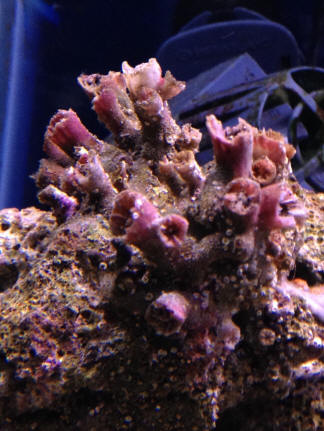 |
|
Yo Bob
10/27/13
Mussid ID corr.s, Indo-Pacific Scolymia are now Acanthophyllia
Hi Bob,
<Hey Jules... now am humming the Beatles tune... A to middle C>
It was nice seeing you last weekend, as always.
<Ahh, a very nice time indeed>
I was just browsing Google looking at some coral photos to help
illustrate the answer to a taxonomic question someone sent me, and I
happened to notice that you have a very special photo on your site-- I
know, you probably are thinking that all of your photos are special.
They are, but this one is particularly so. I have attached it here.
<Will look for... oh, I see you explain below>
You use to illustrate Scolymia, hence the name you gave the photo, but
it is not Scolymia. It is Acanthophyllia deshayesiana. It is a common,
high-value import from Indonesia, usually imported as Scolymia,
sometimes as Cynarina, but now legally only as Acanthophyllia. Long
story. The are many many photographs of this coral in aquariums since it
is a very popular aquarium coral. There are to the best of my knowledge
no published photographs of it taken in the wild. Hence my interest in
your photo.
<Ahh, thank you>
You listed Raja Ampat as the locality. Do you remember the depth and any
other details?
<Aye yi yi... I barely remember what I made for bfast this AM. Many
years... decades back, I showed some discipline in labeling just
finished rolls of film with such notes... >
Even the "Cynarina lacrymalis" featured just above the
Acanthophyllia, also photographed at Raja Ampat, is likely a special
photo. I believe it shows Indophyllia macassarensis, which is
sometimes not easy to distinguish from Cynarina lacrymalis, and
sometimes not easy to distinguish from Acanthophyllia deshayesiana. If
you look at my book Corals A Quick Reference Guide you will see that I
grouped these three species into the genus Cynarina, which is what I
suspect will ultimately happen on the taxonomic front, though it may
take many years.
<Am very inclined to beg you to look through my (many, Way too many)
totally unidentified Cnid. pix, let alone my likely mis-id'ds>
With your permission I would like to forward a copy of this photo to
Charlie Veron. He has recently recognized the validity of this coral
(after many years of me beating him over the head about it because he
refused to separate it from Cynarina lacrymalis). He has lots of good
AQUARIUM photos of it to illustrate his online version of Corals of the
World, but he has no underwater photos from the natural setting. I am
sure he would love to feature your photo.
Best Regards, Julian
<Ah, certainly... I will take a quick look on my HD and attach the
original here for all's use; actually three others labeled in the same
series. Cheers, BobF>
|
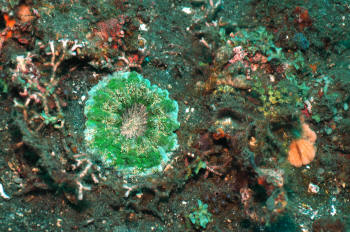
.JPG)
.JPG)
.JPG) |
Re: Yo Bob
10/27/13
Thank you Bob, these photos are GREAT !
<Ah my friend; it's the gear and opportunity>
I need to go to Raja Ampat.
<Oh! I'll gladly go w/ you... Really! Have the time, funds; just fresh out
of dive-adventure partners... Is a fab area... Arenui, Cheng Ho...>
I have sent them on to Charlie Veron and I am sure he will contact you about
them at some point.
<Ahh!>
Best Regards,
<Cheers, and again, am not joshing re getting out for diving tog. BobF>
Julian
10/28/13
Julian... on being a bit more awake, re-reading your msg., have noted your
ref. to "Cynarina" I likely have (mis)labeled from RA. Have included the
three images from my HD here for your and JEN's perusal. Cheers, BobF |
.JPG) .JPG)
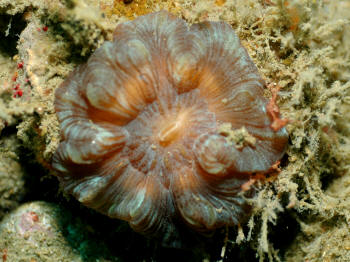 |
Re: Yo Bob
10/28/13
Thank you Bob, FYI,
Cynarina lacrymalis RA (1).JPG is Cynarina lacrymalis
Cynarina lacrymalis RA (2).JPG is Indophyllia macassarensis
Cynarina lacrymalis RA.JPG is Trachyphyllia geoffroyi
<Am more and more convinced to have you ID all Scleractinian pix! Thank you
again. Bob>
Best Regards,
Julian Acanthophyllia photos
10/28/13
Hi Bob,
<Hey Dr. V., I met you years back when John Jackson (RIP) had you over to
the States for the MACNA hobby conference>
Julian forwarded your photos of Acanthophyllia to me. And yes, I would
indeed like to use them on Corals of the World website. Acknowledged of
course. Is this OK with you?
<Ah yes; you (and all educational, non-commercial) uses of my work are fine
to use>
Very nice photos.
<Ahh; thank you. Am grateful to JulianS for straightening me out on these
(and so many more likely) inaccurate ID.s>
Best wishes, Charlie
<Cheers, BobF>
Re Acanthophyllia photos 10/28/13
Many thanks Bob.
<Glad to share. BobF>
Charlie
|
|
LPS ID
10/24/13
Hi Guys,
Could I bother you for an ID on the attached. I have tried
Googling but tend to go around in circles with no definitive answer.
I suspect a Lobophyllia...but.. Its about 6 inches across with multiple
mouths.
<I see this/these... can you lift up the specimen, either take/send a
photo or a description of what the skeleton is like underneath?
Phaceloid, V-shaped, or?.... Take care not to have the specimen
brush your wrist, forearm.
Bob Fenner>
Thanks in advance,
David
|
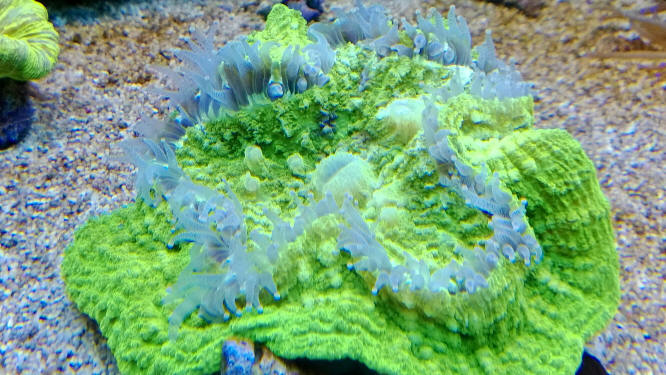 |
Re: LPS ID 10/25/13
Hi Bob,
<Hello David>
Thanks for the prompt reply. When I am doing my maintenance over the
weekend I will take a picture.
<Real good>
However I cannot recall any significant detail visible from below.
Unlike other LPS in my tank I have never seen it in any state other than
expanded and never been able to make out any detail of it's skeletal
structure from above. It started out with one mouth but as it grew the
"secondary" mouths started to appear.
<A good characteristic, delimiter of possibilities... as will aspects of the
under-skeleton be>
As you can probably tell from the picture the tentacles do not form a circle
but are arranged in lobes or clover leaf type pattern towards the outside of
the coral.
I have looked for IDs on other forums with little success and expected you
to reply with an "its a plain old **** **** ", so no pressure there :)
<I only have a few guesses re at this point. Often there are "aberrations"
in the appearance of stony and soft corals grown under captive conditions
(different than wild)>
I'm quite curious as I really like it and would love to get another one or
two particularly if other colors were available.
<Likely this one can be (easily) fragged.... either parts broken or cut off
including a mouth, or unceremoniously broken in pieces approximately from
the center out. It is a beauty>
I will get back as soon as I have the detail you require.
David
<Cheers, BobF>
Re: LPS ID
10/25/13
Bob,
Impatience got the better of me so maybe this will help <Ahh; does appear to
be a Mussid of some sort... Perhaps of the genus Lobophyllia as you've
speculated. B> |
 |
Re: LPS ID
10/25/13
Many thanks Bob
<Thank you David. B> |
|
|

